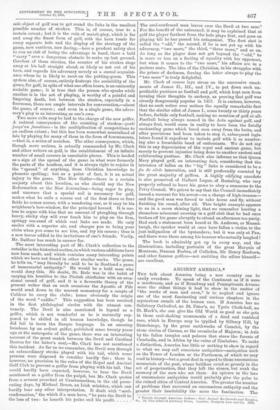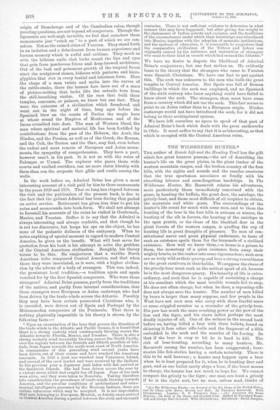ANCIENT AMERICA.* THE talk about America being a new country
can be easily overdone. To speak of the Continent as if it were a mushroom, and as if Broadway and Pennsylvania Avenue were the oldest things it had to show in the matter of "the works of men and oxen," is to neglect and ignore one of the most fascinating and curious chapters in the mysterious annals of the human race. If America has no Salisbury Cathedral, no St. Peter's, no Yprbe Cloth-hall, no St. Mark's, she can give the Old World as good as she gets in those soul-shaking monuments of a dead and vanished race, which in Europe may be typified by Silbury Hill, by Stonehenge, by the great earthworks of Camelot, by the stone circles of Oarnao, or the cromlechs of Majorca; in Asia by the fallen temples and palaces that strew the forests of Cambodia, and in Africa by the ruins of Zimbabwe. To make a distinction, America has little or nothing to show in regard to what we may call conscious antiquities—antiquities such as the Tower of London or the Parthenon, of which we may read in history—but a great deal in regard to those unconscious memorials of the past, whose builders erred so grossly in the art of perpetuation, that they left the stones, but sunk the memory of the men who set them. An epicure in the lore of unconscious antiquities would probably give the palm to the ruined cities of Central America. The greater the number of problems that surround an unconscious antiquity and the greater their insolubility the more the fascination. The • Travels Amongst American Indians : their Ancient Earthworks and Temples, &c. Br Viee.Admiral Lindesay Brine, London: Sampson Low and Co. 1894. origin of Stonehenge and of the Cambodian ruins, though puzzling questions, are not beyond all conjecture. Though the ligaments are well-nigh invisible, we feel that somehow these monuments just "catch on" to a past of which we are con- scious. Not so the ruined cities of Yucatan. They stand forth in an isolation and a detachment from human experience and human memory which is awful and sublime. They mock us with the hideous smile that lurks round the lips and eyes that grin from ponderous frieze and deep-browed architrave. Out of the lush and poisonous growth of the tropical forest start the sculptured stones, hideous with patterns and hiero- glyphics that riot in every bestial and inhuman form. Here the shape of, a man twists and melts into the curves of the rattle-snake, there the human face leers out of a mass of picture-writing that looks like the entrails torn from the still-breathing victim. Of the race that built these temples, convents, or palaces, we know but one fact. They were the outcome of a civilisation which foundered and went out in the night of time, long ages before the Spaniard blew on the coasts of Darien the magic horn • at whose sound the Empires of Montezuma and of the Incas crumbled into dust. The man of Western blood, the man whose spiritual and material life has been fortified by contributions from the past of the Hebrew, the Arab, the Hindoo, and the Persian, as well as of the Greek, the Roman, and the Celt, the Teuton and the Slav, may feel, even before the rudest and most remote of European and Asian monu- ments, the sympathy of comprehension. They have a part, however small, in his past. It is not so with the ruins of Palenque or Uxmal. The explorer who paces those wide courts and vaulted corridors, can no more claim kinship with them than can the serpents that glide and rustle among the walls.
In the work before us, Admiral Brine has given a most interesting account of a visit paid by him to these monuments in the years 1869 and 1870. That so long has elapsed between the visit and the publication of the present book, is due to the fact that the gallant Admiral has been during that period on active service. Retirement has given him time to put his notes and memoranda into book-form. We shall not attempt to forestall his accounts of the ruins he visited in Guatemala, Mexico, and Yucatan. Suffice it to say that the Admiral is always interesting and always readable, and that though he is not too discursive, but keeps his eye on the object, he has none of the pedantic dullness of the antiquary. When he notes anything of special moment in regard to modern Central America, he gives us the benefit. What will best serve for quotation from his book is his attempt to solve the problem of the Central American civilisation. Roughly, his theory seems to be this. He conjectures that a warlike North American tribe conquered Central America, and that when there they were inoculated, as it were, with a higher civilisa- tion by the advent of a body of strangers. This was, indeed, the persistent local tradition,—a tradition again and again vouched for by the first Spanish conquerors. Who were these strangers F Admiral Brine guesses, partly from the traditions of the natives, and partly from internal considerations, that these strangers were European or Asian castaways, who had been driven by the trade-winds across the Atlantic. Possibly they may have been certain persecuted Christians who, it is recorded, were driven out of Spain and Portugal by the Mahommedan conquerors of the Peninsula. That there is nothing physically impossible in his theory is shown by the following facts :— " Upon an examination of the laws that govern the direction of the trade-winds in the Atlantic and Pacific Oceans, it is found that there is a strong easterly wind continuously blowing across the Atlantic towards Florida, Mexico, and Yucatan. There is also a- strong westerly wind invariably blowing across the North Pacific, over the regions between the fortieth and fiftieth parallels of lati- tude, from Japan towards the north-west coast of North America. In consequence of this prevailing wind several junks have been driven out of their course and have reached the American seacoasts. In 1833 a junk was wrecked near Vancouver Island, and several of the crew landed and were received by the Indians. In the previous year a Japanese junk laden with fish arrived at the Sandwich Islands. She had been driven across the seas by a violent storm which bad caught her off Japan. Four of her men ware alive, and they were taken to Honolulu. Taking therefore into consideration the prevalence of trade-winds blowing towards America, and the peculiar conditions of architectural and astro- nomical intelligence possessed by the Mexican Indians, there are certain inferences which may be accepted. It is not improbable that men belonging to European, Moorish, or Asiatic races arrived in Central America during a period between the sixth and eleventh
centuries. There is not sufficient evidence to determine in what manner this may have happened ; but after giving due weight to the statements of Indian priests and caciques, and the traditions of the circumstances under which their knowledge was introduced into Mexico, together with the adoption of monastic institutions, and the systems of education, it is reasonable to conjecture that the comparative civilisation of the Toltecs and Aztecs was originally caused by the influence and instruction of strangers who came to their land in vessels which had crossed the Atlantic."
We have no desire to dispute the likelihood of Admiral Brine's conjectures ; but one fact strikes us. He evidently leans to the theory that the strangers who came to Yucatan were Spanish Christians. We have one fact to put against this. The arch was unknown to the men who built the great temples in Central America, But Spain was full of Roman buildings in which the arch was employed, and no Spaniard of the sixth century who knew anything could have failed to know about the arch. The strangers, then, must have come from a country which did not use the arch. This fact seems to point to an Asian rather than to a European origin. Hindoo castaways would not have introduced the arch, for it did not belong to their architectural system.
We have left ourselves no space to speak of that part of Admiral Brine's book which deals with the great earthworks in Ohio. It must suffice to say that it is as interesting, as that which is occupied with the Central American ruins.



















































 Previous page
Previous page